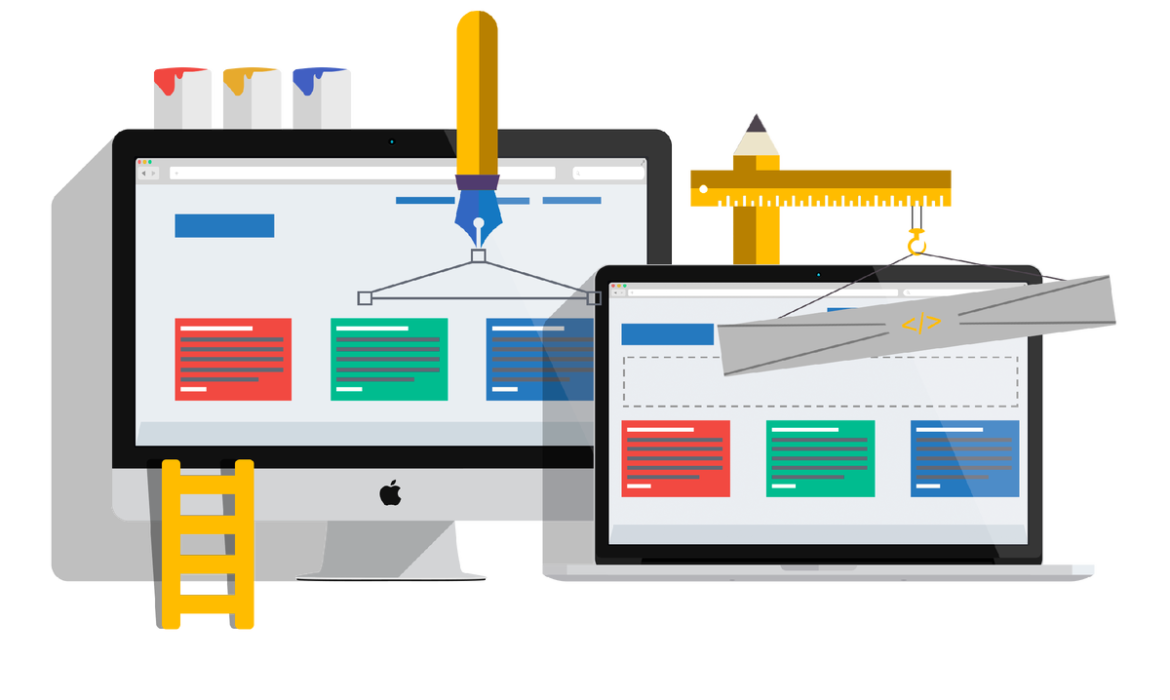Exploring Artificial Intelligence (AI) and Machine Learning in Web Development
Introduction
In the dynamic realm of web development, the boundaries between traditional programming and cutting-edge technologies are blurring rapidly. Artificial Intelligence (AI) and Machine Learning (ML) are no longer confined to the realm of science fiction; they are becoming integral tools for building smarter, more interactive, and user-centric web applications. As web developers, it is crucial to embrace these advancements and explore how AI and ML can transform our craft.
AI and ML: Supercharging Web Development
AI and ML offer a plethora of opportunities to enhance web development practices:
Personalized User Experiences: AI algorithms can analyze user behavior and preferences to deliver tailored content, recommendations, and experiences, fostering user engagement and satisfaction.
Intelligent Chatbots: AI-powered chatbots can provide 24/7 customer support, answer questions, and resolve issues, enhancing customer service and reducing support costs.
Predictive Analytics: ML models can analyze data to predict user behavior, identify trends, and make informed decisions, enabling proactive content delivery and resource optimization.
Anomaly Detection: AI algorithms can detect unusual patterns and anomalies in data, flagging potential security threats, fraudulent activities, or system malfunctions.
Sentiment Analysis: AI tools can analyze user feedback, social media posts, and online reviews to gauge public sentiment, identify areas for improvement, and enhance brand reputation.
AI-Powered Tools for Web Developers
A vast array of AI and ML tools are emerging to empower web developers:
AI APIs: Integrate AI capabilities into web applications using APIs from providers like Google Cloud AI, Amazon AI, and Microsoft Azure AI.
AI Frameworks: Leverage AI frameworks like TensorFlow.js and PyTorch.js to build custom AI models for web applications.
AI-Powered Libraries: Utilize libraries like Rasa and Dialogflow to create intelligent chatbots and conversational interfaces.
AI-Driven Analytics Platforms: Employ analytics platforms like Google Analytics 360 and Adobe Analytics to gain insights from user data and make AI-driven decisions.
AI and ML: Shaping the Future of Web Development
AI and ML are poised to revolutionize web development in the years to come:
AI-Powered Web Design: AI tools will assist in creating personalized website layouts, optimizing content placement, and enhancing user engagement.
Intelligent Code Generation: AI will assist in writing code, generating test cases, and debugging software, improving developer productivity.
AI-Driven Security: AI will enhance cybersecurity by detecting threats, preventing intrusions, and safeguarding sensitive user data.
Augmented Web Experiences: AI will enrich web applications with interactive features, virtual assistants, and immersive experiences.
Conclusion
AI and ML are not just about replacing traditional web development practices; they are about augmenting human capabilities and creating web applications that are smarter, more responsive, and personalized. As web developers, it is our responsibility to embrace these technologies and explore how they can elevate our craft to new heights. The future of web development is inextricably linked to AI and ML, and those who embrace this convergence will be at the forefront of shaping the next generation of web experiences.
Call to Action
Ready to explore the world of AI-powered web development?
Our team of experienced AI engineers and web development experts can help you integrate AI and ML into your web applications, enabling you to deliver personalized experiences, enhance user engagement, and build web applications that are truly intelligent and future-proof. We’ll work closely with you to assess your project requirements, identify AI and ML opportunities, and implement the right solutions to transform your web development process and deliver exceptional results.
Optimizing Web Performance: Speed, Scalability, and User Experience
Introduction
In today’s fast-paced digital world, web performance has become a critical factor for success. Users expect websites to load quickly, respond seamlessly, and provide a smooth and engaging experience. If a website fails to meet these expectations, users are quick to abandon it, leading to lost traffic, decreased conversion rates, and a tarnished brand reputation. To combat this, web developers must prioritize performance optimization, ensuring that their websites deliver exceptional user experiences that keep visitors engaged and coming back for more.
The Impact of Web Performance
Enhanced User Experience: Faster page load times, reduced latency, and improved responsiveness lead to a more satisfying and enjoyable user experience.
Example: Imagine visiting an e-commerce website. If the product pages take too long to load, you’re likely to get impatient and abandon your shopping cart. However, if the pages load quickly and smoothly, you’re more likely to browse products, add items to your cart, and complete the purchase.
Increased Conversion Rates: A well-performing website encourages users to stay longer, explore more content, and ultimately make purchases or complete desired actions.
Example: A news website with slow loading times may see a decrease in the number of articles read and comments submitted. Conversely, a news website that loads quickly and efficiently is more likely to engage users, leading to increased readership and interaction.
Improved Search Engine Rankings: Search engines prioritize websites that load quickly and provide a positive user experience, boosting their visibility in search results.
Example: A slow-loading website may not rank as high in search results as a website with optimized performance. This can lead to decreased organic traffic and fewer potential customers.
Reduced Bounce Rates: Users are less likely to abandon a website if it loads quickly and functions smoothly, decreasing bounce rates and improving engagement.
Example: A high bounce rate indicates that users are not finding what they’re looking for or are frustrated with the website’s performance. Optimizing performance can help reduce bounce rates and keep users engaged.
Enhanced Brand Reputation: A fast and responsive website reflects professionalism and attention to detail, fostering a positive brand image and increasing customer trust.
Example: A company with a slow and buggy website may be perceived as outdated or unreliable. On the other hand, a company with a high-performing website is more likely to be seen as innovative and trustworthy.
Essential Performance Metrics for Web Developers
Page Load Time: The time it takes for a web page to fully load and become interactive.
Measurement: Use tools like Google PageSpeed Insights or WebPageTest to measure page load time.
First Contentful Paint (FCP): The time it takes for the first bit of content to appear on the screen.
Measurement: Use browser developer tools or performance monitoring tools to measure FCP.
Time to Interactive (TTI): The time it takes for the page to become fully interactive, allowing users to interact with elements.
Measurement: Use browser developer tools or performance monitoring tools to measure TTI.
Total Blocking Time (TBT): The time during which the browser is unable to render the page due to blocking scripts or network requests.
Measurement: Use browser developer tools or performance monitoring tools to measure TBT.
Largest Contentful Paint (LCP): The time it takes for the largest piece of content to load and become fully visible.
Measurement: Use browser developer tools or performance monitoring tools to measure LCP.
Cumulative Layout Shift (CLS): The amount of unexpected layout shifts that occur as the page loads, affecting user experience.
Measurement: Use browser developer tools or performance monitoring tools to measure CLS.
Page Load Optimization Techniques
Minify HTML, CSS, and JavaScript: Reduce file sizes by removing unnecessary whitespace, comments, and code redundancies.
Tools: Use tools like HTMLMinifier, CSSO, and UglifyJS to minify code.
Optimize Images: Compress images to reduce file sizes without sacrificing quality, using appropriate image formats and dimensions.
Tools: Use tools like TinyPNG, Kraken.io, or ImageOptim to optimize images.
Leverage Browser Caching: Enable browser caching to store static resources locally, reducing the need for repeated downloads.
Implementation: Set appropriate cache headers in the server configuration.
Utilize a Content Delivery Network (CDN): Distribute content across geographically dispersed servers to reduce latency and improve global performance.
Providers: Popular CDN providers include Cloudflare, Akamai, and Amazon CloudFront.
Website Design Patterns Effectively: A Comprehensive Guide
Introduction
In the dynamic realm of web development, website design patterns have emerged as invaluable tools for crafting intuitive and user-friendly interfaces. These established solutions to common design challenges provide a structured approach to website development, ensuring consistency, usability, and a seamless user experience.
Understanding the Essence of Website Design Patterns
Website design patterns serve as blueprints for common design elements and interactions, such as navigation menus, search bars, and form fields. By leveraging these patterns, designers can streamline the design process, reduce development time, and maintain consistency across the website.
Key Principles for Effective Website Design Pattern Usage
Identify Common Design Challenges: Begin by identifying recurring design problems that users frequently encounter. These challenges could involve navigation issues, confusing layouts, or unclear form interactions.
Select Appropriate Design Patterns: Once you’ve identified the challenges, seek out established design patterns that address those specific issues. Numerous pattern libraries, such as Pattern Library and Bootstrap, offer a wealth of well-tested patterns to choose from.
Consider Context and Customization: While patterns provide a solid foundation, it’s crucial to adapt them to the specific context of your website. Consider the overall design style, user demographics, and functionality requirements when customizing patterns.
Maintain Consistency and Usability: Ensure that the chosen patterns are applied consistently throughout the website. This consistency creates a sense of familiarity and predictability for users, enhancing their overall experience.
Test and Iterate: Regularly test the website’s usability and gather user feedback. Use this feedback to refine the implementation of design patterns and make necessary adjustments.
Benefits of Utilizing Website Design Patterns
Improved User Experience: Design patterns promote usability and intuitiveness, making it easier for users to navigate and interact with the website.
Enhanced Design Efficiency: Patterns streamline the design process, saving time and effort for designers and developers.
Consistent User Interface: Consistent application of patterns ensures a cohesive and predictable user interface across the website.
Reduced Development Time: By utilizing pre-established patterns, developers can focus on building the website’s functionality rather than reinventing the wheel for every design element.
Maintainability and Scalability: Patterns facilitate easier website maintenance and updates, making it simpler to adapt to changing requirements and scale the website as needed.
Conclusion
Website design patterns are not mere shortcuts; they are powerful tools that, when used effectively, can elevate the user experience and streamline the web development process. By embracing these patterns, designers and developers can create websites that are not only visually appealing but also intuitive, consistent, and user-friendly. Remember, website design patterns are not rigid rules but rather flexible guidelines that should be adapted to the specific needs of each project.
Website Accessibility: Ensuring Your Site is Inclusive for All Users
Introduction
In today’s interconnected world, the internet serves as a gateway to information, resources, and opportunities. However, not everyone can experience the full potential of the web due to accessibility barriers. Website accessibility entails designing and developing websites that are inclusive and usable for all individuals, regardless of their physical, sensory, or cognitive abilities.
Embracing Inclusive Web Design Principles
Inclusive web design goes beyond aesthetics; it’s about creating a digital space that is welcoming and empowering for everyone. By incorporating accessibility principles into your website development process, you can ensure that your site is accessible to a wider audience, including individuals with disabilities, such as visual impairments, hearing impairments, and motor impairments.
Key Elements of Accessible Websites
Perceivable: Ensure that all content is perceivable through multiple senses, including sight, hearing, and touch. Provide alternative text for images, transcripts for videos, and captions for audio content.
Operable: Make all interactive elements operable and controllable using various input methods, such as keyboards, screen readers, and assistive technologies. Ensure that navigation is clear and consistent, and provide sufficient time for users to interact with elements.
Understandable: Ensure that the content and user interface are understandable and easy to navigate. Use clear and concise language, avoid jargon, and provide contextual information for non-obvious elements.
Robust: Ensure that the website is robust and compatible with a wide range of assistive technologies and user agents. Follow web standards and guidelines, and thoroughly test the website’s accessibility across different devices and browsers.
Benefits of an Accessible Website
Enhanced User Experience: An accessible website provides a positive and inclusive experience for all users, regardless of their abilities.
Improved Search Engine Optimization (SEO): Search engines consider accessibility a ranking factor, and accessible websites tend to perform better in search results.
Legal Compliance: Many countries and regions have laws and regulations mandating website accessibility, such as the Americans with Disabilities Act (ADA) in the United States.
Wider Audience Reach: An accessible website caters to a broader and more diverse audience, expanding your potential reach and user base.
Brand Reputation Enhancement: Demonstrating a commitment to accessibility enhances your brand’s reputation and conveys a message of inclusivity and social responsibility.
Conclusion
Website accessibility is not just an afterthought; it’s a fundamental aspect of responsible web development. By embracing inclusive design principles and adhering to accessibility guidelines, you can create a website that is not only functional and visually appealing but also welcoming and usable for all individuals. Remember, an accessible website is not just a legal requirement; it’s a moral imperative that ensures that everyone can participate fully in the digital world.
Call to Action:
Ready to make your website truly accessible?
Our team of experienced accessibility experts can help you assess your website’s current accessibility level, identify areas for improvement, and implement strategies to ensure compliance with WCAG guidelines and relevant accessibility standards. We’ll work with you to create a website that is inclusive, user-friendly, and legally compliant. Contact us today to get started on making your website a place where everyone feels welcome and empowered.
Creating a Responsive Website: Adapting to Different Screen Sizes
Introduction
In today’s dynamic digital landscape, where users access websites through a diverse range of devices, from desktops to smartphones and tablets, creating a responsive website has become essential. A responsive website ensures that your content and design adapt seamlessly to different screen sizes, providing a consistent and user-friendly experience regardless of the device being used.
Embracing Responsive Web Design Principles
Responsive web design (RWD) is a web development approach that focuses on building websites that can dynamically adjust their layout and presentation to fit the screen size and orientation of the device being used. This means that whether a user is viewing your website on a large desktop monitor, a compact tablet, or a handheld smartphone, they will have a consistent and optimal viewing experience.
Key Techniques for Creating Responsive Websites
Flexible Layouts: Employ fluid grids and flexible layouts that can expand and contract to accommodate different screen sizes. This allows elements on the page to rearrange and resize themselves to fit the available space without breaking the design.
Media Queries: Utilize media queries, which are CSS rules that apply styles based on specific conditions, such as screen size, orientation, or device type. Media queries allow you to target specific devices and adjust the website’s presentation accordingly.
Responsive Images: Use responsive images that can scale up or down based on the device’s screen size and resolution. This ensures that images display at an appropriate size and quality without affecting page load times.
Responsive Typography: Adjust font sizes, line heights, and letter spacing based on the screen size to ensure optimal readability across different devices.
Touchscreen Optimization: Consider touch targets and tap areas to ensure that users can easily interact with the website’s elements using touchscreens.
Benefits of a Responsive Website Design
Enhanced User Experience: Responsive websites provide a consistent and user-friendly experience across all devices, reducing frustration and improving user engagement.
Improved Search Engine Optimization (SEO): Google and other search engines favor responsive websites, as they consider mobile-friendliness a ranking factor.
Wider Audience Reach: A responsive website caters to a broader audience, as it can be accessed and enjoyed by users on any device.
Reduced Maintenance Costs: A single responsive website eliminates the need to maintain separate versions for different devices, saving time and resources.
Future-Proofing Your Website: Responsive design ensures that your website can adapt to new devices and screen sizes that emerge in the future.
Conclusion
Creating a responsive website is not just a trend; it’s a necessity for businesses and organizations that want to thrive in today’s digital world. By implementing responsive web design principles, you can create a website that delivers an exceptional user experience, enhances SEO, expands your audience reach, reduces maintenance costs, and future-proofs your online presence. Embrace responsive web design and ensure that your website remains accessible, engaging, and effective across all devices.
Call to Action:
Ready to make your website truly responsive?
Our team of skilled web designers and developers can help you transform your website into a responsive masterpiece. We’ll assess your current website, identify areas for improvement, and implement responsive design strategies that ensure your website looks and functions flawlessly on any device. Contact us today to get started on creating a website that adapts to the ever-evolving digital landscape.
Optimizing Website Performance: Speed, Responsiveness, and User Experience
Optimizing Website Performance: Speed, Responsiveness, and User Experience
Main Category: Web Development Subcategory: Website Performance Optimization Tags: website performance optimization, website speed, website responsiveness, user experience, SEO, conversion rate optimization
Keywords: website performance optimization techniques, website speed optimization, mobile optimization, website responsiveness, UX design, SEO for website performance, conversion rate optimization
Meta Description: Craft a website that not only loads quickly but also delivers a seamless and engaging user experience. Discover essential strategies to optimize website performance, including caching mechanisms, image compression, responsive design, and UX best practices.
Image Alt Text: A diverse group of individuals using various devices to access a website, representing a fast, responsive, and user-friendly online experience.
Introduction
In today’s competitive online landscape, website performance is no longer an afterthought; it’s a critical factor that can make or break your digital presence. A slow, unresponsive website can frustrate visitors, increase bounce rates, and negatively impact your search engine ranking. Conversely, a fast, responsive website that delivers a seamless user experience can boost engagement, improve conversion rates, and enhance your overall brand reputation.
Essential Strategies for Optimizing Website Performance
1. Leverage Caching Mechanisms:
Caching stores frequently accessed website data in a temporary location, reducing server load and improving response times for returning visitors. Common caching mechanisms include:
- Browser caching: Stores static files like CSS, JavaScript, and images on the user’s browser for faster loading on subsequent visits.
- Server-side caching: Stores frequently accessed data on the server, reducing the need to retrieve it from the database each time.
- Content Delivery Networks (CDNs): Replicate website content across geographically distributed servers, delivering content to users from the closest server for faster loading times.
2. Minify and Compress Website Assets:
Minification removes unnecessary characters (e.g., whitespace, comments) from CSS, JavaScript, and HTML files, reducing file sizes and improving loading speeds. Compression further reduces file sizes by encoding them using algorithms like Gzip or Brotli.
3. Optimize Image Formats and Sizes:
Large image files can significantly slow down your website. Use efficient image formats like JPEG for photos and PNG for graphics. Optimize image sizes using tools like Photoshop or online compressors. Consider using lazy loading for images below the fold.
4. Implement a Content Delivery Network (CDN):
A CDN stores website content on geographically distributed servers, delivering content to users from the closest server. This reduces latency (loading time) for users, especially those located far from your physical server.
5. Minify and Compress HTML Code:
Similar to minifying CSS and JavaScript files, minifying HTML code removes unnecessary characters and whitespace, reducing file size and improving loading speeds.
6. Use Efficient Database Queries and Avoid Unnecessary Database Calls:
Inefficient database queries can strain your server’s resources and slow down website performance. Optimize your database queries to retrieve data efficiently and avoid making unnecessary database calls.
7. Monitor Website Performance Using Tools Like Google PageSpeed Insights and Address Identified Bottlenecks:
There are several website performance monitoring tools available, such as Google PageSpeed Insights and GTmetrix. These tools can identify performance bottlenecks and provide specific recommendations for improvement.
8. Prioritize Mobile Optimization:
With the increasing prevalence of mobile browsing, it’s crucial to ensure your website is optimized for mobile devices. Use responsive design techniques to ensure your website adapts seamlessly to different screen sizes and provides a consistent user experience across devices.
9. Employ Lazy Loading for Images and Other Resources:
Lazy loading defers the loading of non-critical resources (e.g., images below the fold) until they are scrolled into view by the user. This prioritizes the loading of above-the-fold content, improving initial page load speed.
10. Keep Your Website Up to Date:
Regularly update your website’s content, software, and plugins to ensure optimal performance and security. Outdated software can introduce vulnerabilities and compatibility issues that can slow down your website.
Additional Tips for a Fast and Responsive Website
- Choose a reliable hosting provider: Your hosting provider plays a significant role in your website’s performance. Select a hosting provider that offers adequate bandwidth, storage, and server resources to handle your website’s traffic.
- Optimize your website’s code: Use clean, well-structured code that is free of errors and redundancies.
- Reduce the number of HTTP requests: Each HTTP request adds to the overall page load time. Minimize the number of HTTP requests by combining files and using sprites for images.
- Use a lightweight theme or template: Avoid using overly complex themes or templates that can bloat your website’s code and slow down loading times.
- Use a Content Management System (CMS) that is optimized for performance: Choose a CMS that is known for its efficiency and has a track record of providing good performance.
- Optimize your website’s images for SEO: Use appropriate image alt tags and file names to help search engines index your images and improve your website’s visibility in search results.
- Test your website on different browsers and devices: Ensure that your website performs well and looks consistent across different browsers and devices.
- Use a performance monitoring tool to track your website’s speed over time: Continuously monitor your website’s performance to identify any issues that may arise and make adjustments as needed.
Benefits of Optimizing Website Performance
Optimizing your website’s performance can bring numerous benefits, including:
- Improved User Experience: A fast and responsive website provides a better user experience, which can lead to increased engagement, longer time spent on the site, and higher conversion rates.
- Enhanced SEO: Search engines favor websites that load quickly and are mobile-friendly. Optimizing your website’s performance can improve your search engine ranking and drive more organic traffic.
- Reduced Bounce Rate: Visitors are less likely to bounce from a website that loads quickly and provides a seamless user experience.
- Increased Conversion Rates: A faster website can lead to higher conversion rates, as users are more likely to complete desired actions, such as making a purchase or signing up for a newsletter.
- Lower Operating Costs: A well-optimized website can reduce server load and bandwidth usage, which can lead to lower hosting costs.
Conclusion
Optimizing website performance is an ongoing process that requires continuous monitoring and adjustment. By implementing the strategies and tips outlined in this blog post, you can create a website that is not only fast and responsive but also delivers a seamless and engaging user experience. A well-optimized website can significantly benefit your business by improving user engagement, boosting SEO, increasing conversion rates, and reducing operating costs. Remember, a fast and responsive website is an essential foundation for a successful online presence.
Call to Action:
Ready to take your website performance to the next level?
Our team of experienced web developers and performance optimization specialists can help you identify and address performance bottlenecks, optimize your website’s code and assets, and implement strategies to ensure a consistently fast and responsive user experience. Contact us today to schedule a consultation and get started on creating a website that performs as well as it looks.
Creating an Engaging and User-Friendly Blog Design: A Comprehensive Guide
Introduction
In today’s content-driven world, blogs have become powerful tools for sharing ideas, connecting with audiences, and establishing thought leadership. However, creating a successful blog goes beyond crafting compelling content; it demands a thoughtful approach to blog design that prioritizes user experience (UX) and visual appeal. An engaging and user-friendly blog design not only enhances the reading experience but also encourages visitors to stay longer, explore more content, and return for future visits.
Key Principles for User-Friendly Blog Design
1. Understand Your Audience:
- Demographics: Identify the age, interests, and online behavior of your target readers.
- Content Preferences: Analyze the types of content they enjoy and how they consume it.
- Devices: Determine the devices they typically use to access blogs.
2. Prioritize Readability:
- Clear and Concise Writing: Use simple language, avoid jargon, and break down complex topics into digestible chunks.
- Easy-to-Read Fonts: Choose fonts that are legible and visually appealing across different screen sizes.
- Optimal Line Spacing: Maintain ample line spacing to avoid visual clutter and enhance readability.
- Consistent Text Color and Background: Use a high contrast ratio between text and background for better readability.
3. Create a Visually Appealing Layout:
- Whitespace: Utilize whitespace effectively to create a clean and uncluttered layout.
- Visual Hierarchy: Employ visual cues like font size, color, and placement to guide readers’ attention.
- Compelling Images: Use high-quality, relevant images to break up text and add visual interest.
- Consistent Branding: Maintain a consistent brand identity throughout the blog, including logo, colors, and typography.
4. Ensure Easy Navigation:
- Clear Menu Structure: Create a simple and intuitive menu that allows users to easily find desired categories and posts.
- Breadcrumbs: Implement breadcrumbs to provide context and help users navigate within the blog.
- Search Functionality: Include a robust search bar to enable users to quickly find specific content.
- Back to Top Button: Add a “back to top” button to allow users to easily return to the top of the page.
5. Optimize for Mobile Devices:
- Responsive Design: Ensure your blog design adapts seamlessly to different screen sizes and devices.
- Mobile-Friendly Fonts: Choose fonts that render well on mobile devices.
- Touch-Friendly Elements: Use larger buttons, clear spacing, and tappable elements for easy navigation on touchscreens.
- Accelerated Mobile Pages (AMP): Consider implementing AMP to improve loading speed on mobile devices.
Additional Tips for an Engaging Blog
- High-Quality Content: Consistently publish valuable, informative, and engaging content that resonates with your audience.
- Regular Posting Schedule: Maintain a consistent posting schedule to keep readers engaged and coming back for more.
- Social Media Promotion: Share your blog posts on social media platforms to expand your reach and attract new readers.
- Author Bios and Guest Posts: Introduce your blog authors and feature guest posts to add variety and credibility.
- Comment Moderation: Encourage reader interaction by moderating comments and responding to feedback.
Conclusion
By following these essential principles and incorporating these additional tips, you can create an engaging and user-friendly blog that not only attracts readers but also fosters a loyal following and drives meaningful engagement. Remember, a successful blog design is an ongoing process that requires continuous refinement and adaptation to evolving user preferences and design trends.
Would you like to add a call to action to this blog post?
Call to Action:
Ready to transform your blog into an engaging and user-friendly online hub?
Our team of experienced designers and content strategists can help you create a blog that captivates your audience, enhances your brand reputation, and drives results. Contact us today for a free consultation!
Designing a Professional Business Website That Converts
Introduction
In today’s competitive digital landscape, a professional business website is no longer a luxury but a necessity. It serves as your virtual storefront, showcasing your brand, products, and services to a global audience. A well-designed website can attract new customers, enhance brand reputation, and drive business growth. However, creating a professional website that truly converts requires a strategic approach that combines user experience (UX) principles, conversion optimization techniques, and effective design elements.
Key Elements of a Professional Business Website
1. Define Your Website Goals:
- Clarity of Purpose: Clearly define what you want your website to achieve (e.g., generating leads, increasing sales, building brand awareness).
- Target Audience: Understand your ideal customer’s demographics, needs, and online behavior.
- Competitive Analysis: Analyze your competitors’ websites to identify strengths and areas for differentiation.
2. Prioritize User Experience (UX):
- Intuitive Navigation: Create a clear and easy-to-navigate structure that allows users to find what they need quickly.
- Seamless User Flow: Guide users through a logical and effortless journey from landing page to conversion.
- Mobile Optimization: Ensure your website is responsive and optimized for all devices, including smartphones and tablets.
- Accessibility: Follow accessibility guidelines to make your website inclusive for all users.
3. Craft a Compelling Visual Identity:
- Consistent Branding: Maintain a consistent brand identity across all pages, including logo, colors, and typography.
- High-Quality Visuals: Use professional images, graphics, and videos to showcase your products or services.
- Visual Hierarchy: Use color, whitespace, and typography to guide users’ attention and create a visually appealing layout.
4. Optimize for Conversion:
- Clear Calls to Action: Prominently display calls to action that encourage users to take desired actions (e.g., contact us, sign up, make a purchase).
- Compelling Content: Create informative, engaging, and persuasive content that resonates with your target audience.
- Trust and Security Signals: Display trust badges, security certificates, and clear contact information to build trust.
- A/B Testing: Experiment with different design elements, layouts, and calls to action to optimize conversion rates.
5. Leverage Technology and Analytics:
- Choose a Reliable Platform: Select a website platform that suits your business needs and technical capabilities.
- Implement Analytics Tools: Track website traffic, user behavior, and conversion rates to measure performance.
- SEO Optimization: Optimize your website for search engines to improve organic traffic.
- Social Media Integration: Integrate social media sharing buttons and feeds to expand reach.
Additional Tips for a Professional Website
- Focus on Quality and Value: Offer high-quality products, services, and content that provide value to your customers.
- Exceptional Customer Support: Provide prompt, responsive, and friendly customer service to build customer loyalty.
- Content Marketing: Create informative and engaging content to attract organic traffic and establish thought leadership.
- Promotional Strategies: Implement targeted promotions, discounts, and email marketing campaigns to drive sales.
- Continuous Improvement: Continuously monitor website performance, gather customer feedback, and make data-driven improvements.
Conclusion
By following these strategies and staying informed about the latest trends in web design and business marketing, you can create a professional business website that not only attracts visitors but also converts them into loyal customers and drives sustainable business growth. Remember, your website is an ongoing project that requires continuous refinement and optimization to remain competitive and achieve long-term success.
Would you like to add a call to action to this blog post?
Call to Action:
Ready to elevate your business website and transform it into a powerful conversion tool?
Our team of expert web designers and business strategists can help you craft a professional website that aligns with your brand, engages your target audience, and drives results. Contact us today for a free consultation!
Optimizing Your Website for Mobile Devices
Introduction
In today’s mobile-centric world, optimizing your website for mobile devices is no longer an option but a necessity. With the majority of internet users now accessing websites from their smartphones and tablets, a mobile-friendly website is crucial for ensuring a seamless user experience, boosting engagement, and driving conversions.
Understanding Mobile Optimization
What is mobile optimization?
Mobile optimization is the process of adapting your website’s design, functionality, and content to deliver an optimal user experience on mobile devices. This includes factors such as responsive design, fast loading times, touch-friendly elements, and a clear mobile-first approach.
Why is mobile optimization important?
- Enhanced user experience: Mobile users expect a website to be easy to navigate, read, and interact with on their smaller screens.
- Improved search engine rankings: Google prioritizes mobile-friendly websites in its search results.
- Increased engagement and conversions: A mobile-optimized website can lead to higher engagement, longer time spent on site, and more conversions.
- Reduced bounce rates: Mobile users are more likely to leave a website that is not mobile-friendly.
Key Principles of Mobile Optimization
- Responsive design: Ensure your website adapts its layout and content to fit different screen sizes and devices.
- Mobile-first approach: Prioritize the design and development of your website for mobile users first.
- Fast loading times: Optimize your website’s speed to ensure quick page loads on mobile devices.
- Touch-friendly elements: Use larger fonts, clear buttons, and ample spacing for easy navigation on touchscreens.
- Clear call to action: Make it easy for users to take desired actions on their mobile devices.
- Avoid pop-ups and intrusive ads: These can hinder the user experience on smaller screens.
- Optimize images: Compress images without sacrificing quality to reduce page load times.
- Test thoroughly on real devices: Use emulators or real mobile devices to test your website’s performance on different platforms.
Implementing Responsive Design
- Use CSS media queries: These allow your website to adjust its styles based on screen size and device.
- Consider using a responsive framework: Popular options include Bootstrap, Foundation, and Material Design.
- Test your responsive design thoroughly: Ensure it works seamlessly across different devices and browsers.
Prioritizing Mobile-First Design
- Think mobile first: Start by designing for the smallest screen size and then scale up.
- Use a simplified layout: Avoid complex layouts that can be difficult to navigate on mobile.
- Prioritize essential content: Focus on the most important information and features for mobile users.
- Use progressive enhancement: Enhance the experience for desktop users without compromising the mobile experience.
Optimizing for Speed and Performance
- Minify CSS and JavaScript: Reduce file sizes to improve loading times.
- Optimize images: Use appropriate file formats and compression techniques.
- Leverage browser caching: Store static content on the user’s device for faster loading.
- Choose a reliable hosting provider: Ensure your hosting can handle mobile traffic.
Conclusion
By following these comprehensive strategies for mobile optimization, you can ensure that your website delivers an exceptional user experience on all devices, enhancing engagement, driving conversions, and ultimately contributing to your business success. Remember, mobile-first design and responsive principles are essential for creating a website that thrives in today’s mobile-driven landscape.
Would you like to add a call to action to this blog post?
Call to Action:
Ready to optimize your website for mobile devices and deliver an exceptional user experience across all screens?
- Start by assessing your current website’s mobile-friendliness.
- Implement responsive design principles using CSS media queries or a responsive framework.
- Prioritize mobile-first design and focus on the essential user experience for mobile users.
- Optimize your website’s speed and performance to ensure fast loading times.
- Test your website thoroughly on real devices and across different browsers.
Need a professional website setup? Contact us now.
Choosing the Right Website Design for Your Business
Understanding Your Business Goals
Before diving into design elements, clearly define your business objectives.
- Identify your target audience: Understand their demographics, preferences, and online behavior.
- Define your brand identity: Develop a strong brand voice, visuals, and messaging.
- Set clear goals: Determine what you want to achieve with your website (e.g., sales, leads, brand awareness).
Key Elements of Effective Website Design
- User-centric design: Prioritize user experience and make navigation intuitive.
- Responsive design: Ensure your website adapts seamlessly to different devices.
- Clear call to action: Guide visitors towards desired actions with prominent CTAs.
- Visual appeal: Create a visually engaging design that reflects your brand identity.
- Fast loading times: Optimize images and code for quick page load speeds.
- Mobile optimization: Design specifically for mobile users to enhance user experience.
Choosing the Right Design Style
- Minimalist: Clean layouts with ample white space for a modern look.
- Classic: Traditional designs with elegant typography and balanced layouts.
- Creative: Bold and unconventional designs for artistic or innovative businesses.
- Modern: Sleek and contemporary designs with emphasis on visuals.
Incorporating Your Brand Identity
- Color palette: Choose colors that align with your brand’s personality.
- Typography: Select fonts that reflect your brand’s tone and voice.
- Imagery: Use high-quality images that resonate with your target audience.
- Logo placement: Ensure your logo is prominently displayed.
Testing and Refinement
- Gather feedback: Collect input from users to identify areas for improvement.
- A/B testing: Experiment with different design elements to optimize performance.
- Analytics: Track website performance and user behavior to make data-driven decisions.
Conclusion
Selecting the right website design is crucial for your business’s success. By carefully considering your target audience, brand identity, and user experience, you can create a website that effectively communicates your message and drives results.
Need a professional website setup? Contact us now.















